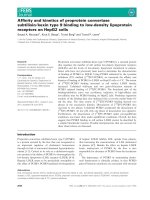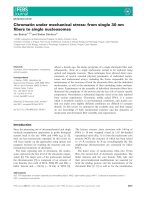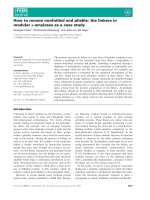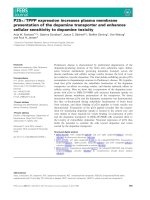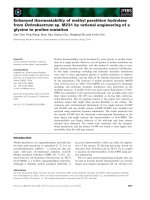Tài liệu Báo cáo khoa học: "Introduction to Computational Advertising" docx
Bạn đang xem bản rút gọn của tài liệu. Xem và tải ngay bản đầy đủ của tài liệu tại đây (64.62 KB, 1 trang )
Tutorial Abstracts of ACL-08: HLT, page 1,
Columbus, Ohio, USA, June 2008.
c
2008 Association for Computational Linguistics
Introduction to Computational Advertising
Evgeniy Gabrilovich Vanja Josifovski Bo Pang
Yahoo! Research
701 First Avenue
Sunnyvale, CA 94085, USA
{gabr,vanjaj,bopang}@yahoo-inc.com
1 Introduction
Web advertising is the primary driving force behind
many Web activities, including Internet search as
well as publishing of online content by third-party
providers. Even though the notion of online ad-
vertising barely existed a decade ago, the topic is
so complex that it attracts attention of a variety of
established scientific disciplines, including compu-
tational linguistics, computer science, economics,
psychology, and sociology, to name but a few. Con-
sequently, a new discipline — Computational Ad-
vertising — has emerged, which studies the process
of advertising on the Internet from a variety of an-
gles. A successful advertising campaign should be
relevant to the immediate user’s information need as
well as more generally to user’s background and per-
sonalized interest profile, be economically worth-
while to the advertiser and the intermediaries (e.g.,
the search engine), as well as be aesthetically pleas-
ant and not detrimental to user experience.
2 Content Overview
In this tutorial, we focus on one important aspect of
online advertising that is relevant to the ACL and
HLT communities, namely, contextual relevance.
There are two main scenarios for online advertis-
ing, as advertisers might request to display their ads
for a query submitted to a Web search engine, or
for a Web page that the user reads online.The for-
mer scenario is called sponsored search, since ads
are matched to the Web search results, and the lat-
ter — content match, as ads are matched to a larger
amount of content. It is essential to emphasize that
in both cases the context of user actions is defined
by a body of text, which could be quite short in the
case of sponsored search or fairly long in the case
of content match. Consequently, the ad matching
problem lends itself to many NLP methods, but also
poses numerous challenges and open research prob-
lems in text summarization, natural language gener-
ation, named entity extraction, computer-human in-
teraction, and others.
At first approximation, the process of obtaining
relevant ads can be reduced to conventional infor-
mation retrieval, where we construct a query that
describes the user’s context, and then execute this
query against a large inverted index of ads. We show
how to augment the standard information retrieval
approach using query expansion and text classifica-
tion techniques. First, we demonstrate how to em-
ploy a relevance feedback assumption and use Web
search results produced by the query. We also go
beyond the conventional bag of words indexing, and
construct additional features by classifying both the
input context and the ad descriptions with respect to
a large external taxonomy. A third type of features
is constructed from a lexicon of named entities ob-
tained by analyzing the entire Web as a corpus.
We present a unified approach to Web advertis-
ing, which uses the same underlying infrastructure
to handle both sponsored search and content match
scenarios. The last part of the tutorial will be de-
voted to recent research results as well as open prob-
lems, such as automatically classifying cases when
no ads should be shown, handling geographic names
(and more generally, location awareness), and con-
text modeling for vertical portals.
1
